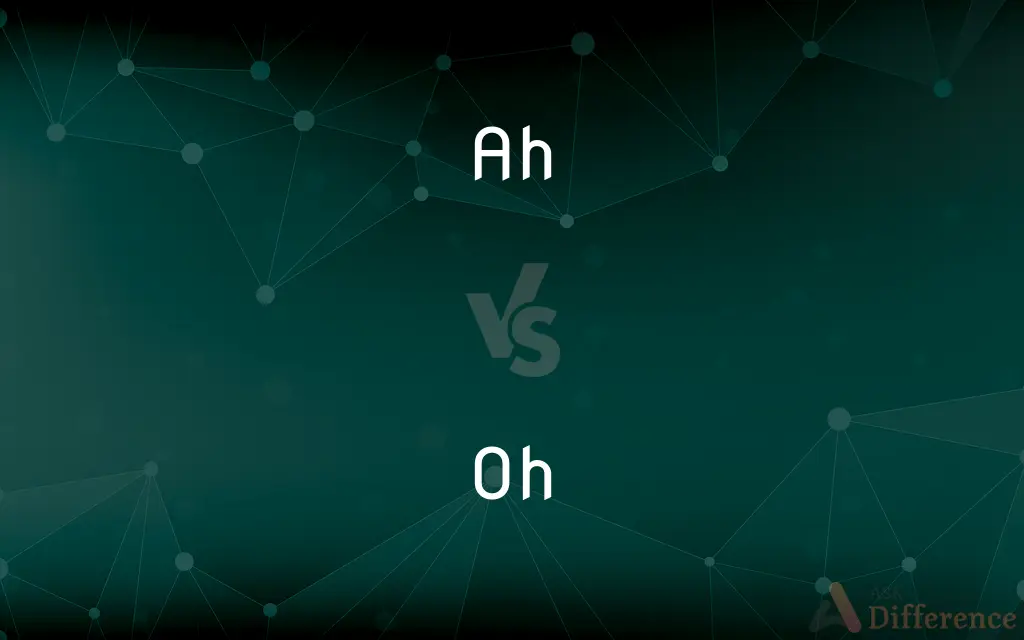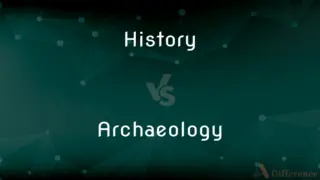Ah vs. Oh — What's the Difference?
By Tayyaba Rehman & Urooj Arif — Updated on March 19, 2024
"Ah" expresses realization or relief, often conveying a sense of discovery or contentment, while "Oh" indicates surprise, comprehension, or acknowledgment, showing a broader range of emotional responses.

Difference Between Ah and Oh
Table of Contents
ADVERTISEMENT
Key Differences
"Ah" is used to express a moment of enlightenment or realization, suggesting that something has just become clear to the speaker. For instance, when someone understands a complex idea, they might say "Ah, now I get it!" This expression can also convey a sense of relief, as when a problem is solved. On the other hand, "Oh" is a versatile interjection that can express surprise, realization, acknowledgment, or even disappointment. It's the tone and context that dictate the specific emotion "Oh" conveys, such as in "Oh, I didn't see you there!" which indicates surprise.
While "Ah" might be used to indicate a pleasant surprise or satisfaction upon finding something ("Ah, here are my keys!"), "Oh" can denote a broader range of reactions from mild interest to significant concern ("Oh, is that how it works?" or "Oh no, what happened?"). This makes "Oh" more flexible in conversation, adapting to various situations based on the speaker's tone and the context.
In literature and speech, "Ah" often marks a turning point in understanding or an expression of insight, serving as a cue that the speaker has reached a new level of comprehension or has been struck by a particular thought. Conversely, "Oh" can introduce new information, signal a change in the conversation's direction, or express an emotional reaction to news or events, making it a key tool for dynamic dialogue.
"Ah" tends to be associated with positive emotions more frequently, such as contentment, relief, or joy. It's the sound of satisfaction, the verbal nod to a puzzle solved or a moment appreciated. Whereas "Oh" is the Swiss Army knife of interjections, capable of expressing a wide spectrum of feelings, from excitement to disappointment, making it indispensable in both casual and formal communication.
The usage of "Ah" and "Oh" also differs in the expression of contemplation or hesitation. "Ah" can preface a statement made after pondering or when an idea crystallizes, emphasizing the end of a thought process. In contrast, "Oh" might be used to buy time while thinking or to indicate that the speaker is about to reveal something previously unconsidered, thus highlighting its role in conversational transitions.
ADVERTISEMENT
Comparison Chart
Primary Expression
Enlightenment, realization, relief.
Surprise, comprehension, acknowledgment, disappointment.
Emotional Connotation
Often positive: satisfaction, contentment.
Broad range: from excitement to concern, depending on context.
Usage in Dialogue
Marks a moment of insight or satisfaction.
Introduces new information, changes in conversation, emotional reactions.
Associated With
Positive revelations, solutions to problems.
A versatile range of emotions and situational responses.
Function in Speech
Emphasizes the end of a thought process, satisfaction.
Indicates a pause for thought, transition, or emotional shift.
Compare with Definitions
Ah
Expression of relief or satisfaction.
Ah, that feels better.
Oh
Showing acknowledgment or understanding.
Oh, I see what you're saying.
Ah
Prefacing a statement of comprehension or conclusion.
Ah, so that's how it's done.
Oh
Expression of surprise or shock.
Oh! I wasn't expecting you.
Ah
Indicating realization or enlightenment.
Ah, now I understand what you mean.
Oh
Expressing disappointment or concern.
Oh no, that's unfortunate.
Ah
Conveying a sense of contentment.
Ah, this is the life.
Oh
Indicating a sudden realization.
Oh, now it makes sense.
Ah
Signifying the discovery of something sought after.
Ah, here are the keys I was looking for.
Oh
Prefacing a response or explanation.
Oh, that's because...
Ah
Used to express various emotions, such as satisfaction, surprise, delight, dislike, or pain.
Oh
Used to express strong emotion, such as surprise, fear, anger, or pain
Oh—can't you stop making so much noise?.
Ah
An expression of relief, relaxation, comfort, confusion, understanding, wonder, awe, etc. according to uttered inflection.
Ah, I understand now.
Ah! It's good to be back home!
Ah, the flowers of spring.
Oh
Used in direct address
Oh, sir! You forgot your keys.
Ah
A syllable used to fill space, particularly in music.
Oh
Used to indicate understanding or acknowledgment of a statement
Oh, I see. You can't come until tomorrow.
Ah
An instance of the interjection ah.
The crowd's oohs and ahs at the fireworks
Oh
Zero.
Ah
To give a cry of "ah".
Oh
Expression of surprise.
Oh! I didn't see you there.
Ah
Pronunciation spelling of I#Pronoun
Oh
Expression of wonder, amazement, or awe.
Oh, wow! That's amazing.
Ah
An exclamation, expressive of surprise, pity, complaint, entreaty, contempt, threatening, delight, triumph, etc., according to the manner of utterance.
Oh
Expression of understanding, affirmation, recognition, or realization.
Oh, so that's how it works.
Oh
A word to precede an offhand or annoyed remark.
Oh, leave me alone.
Oh
A word to precede an added comment or afterthought.
Oh, and don't forget your coat.
Oh
An invocation or address (similar to the vocative in languages with noun declension), often with a term of endearment.
Oh, gosh
Oh
Exclamation for drama or emphasis (often poetic).
Oh, when will it end?
Oh
Expression of pain. See ouch.
Oh! That hurt.
Oh
Space filler or extra syllable, especially in (popular) music.
Oh
(interrogative) Expression of mild scepticism.
"You should watch where you're going!" "Oh?"
Oh
A word to mark a spoken phrase as imaginary.
What if he says "Oh, I need to see your ID"?
Oh
An utterance of oh; a spoken expression of surprise, acknowledgement, etc.
Oh
The letter O, o (more commonly spelled o)
Oh
The digit 0 (especially in representations of speech)
My telephone number is four-double-three-two-oh-nine.
Oh
(intransitive) To utter the interjection oh; to express surprise, etc.
Oh
An exclamation expressing various emotions, according to the tone and manner, especially surprise, pain, sorrow, anxiety, or a wish. See the Note under O.
Oh
A midwestern state in north central United States in the Great Lakes region
Common Curiosities
Can "Ah" and "Oh" be used interchangeably?
While there might be some overlap, they generally serve different emotional and conversational functions.
What does "Ah" express in conversation?
"Ah" typically expresses relief, realization, or contentment, indicating a moment of enlightenment or satisfaction.
Is "Ah" always positive?
"Ah" often conveys positive emotions like relief or satisfaction, but context can shift its meaning.
Can "Oh" express positive emotions?
Yes, "Oh" can express positive emotions, especially when used to convey surprise or acknowledgment in a positive context.
What makes "Oh" a Swiss Army knife of interjections?
Its ability to express a wide range of emotions and responses, from surprise to disappointment, makes it highly versatile.
Do "Ah" and "Oh" have roles in formal communication?
Yes, both can appear in formal communication, though their use might be more restrained and context-specific.
Can "Ah" indicate disappointment?
It's less common, but "Ah" can indicate mild disappointment in certain contexts, especially when expected outcomes are not met.
How do tone and context affect "Ah" and "Oh"?
Tone and context significantly influence the interpretation of these interjections, determining their specific emotional connotation.
Are there any non-verbal cues associated with "Ah" and "Oh"?
Yes, non-verbal cues like facial expressions and body language can enhance the meaning of "Ah" and "Oh" in communication.
Can "Ah" and "Oh" be used in writing?
Yes, both are used in writing to convey dialogue or internal monologue that reflects realization, surprise, or emotional reactions.
How are "Ah" and "Oh" used in literature?
In literature, "Ah" is often used to signify a character's moment of insight, while "Oh" can indicate emotional reactions or conversational transitions.
Is "Oh" more common than "Ah" in conversation?
"Oh" might appear more frequently due to its broad range of applications in expressing various emotions and reactions.
How is "Oh" used differently from "Ah"?
"Oh" is more versatile, expressing surprise, comprehension, acknowledgment, or disappointment, depending on the context.
How do speakers decide when to use "Ah" or "Oh"?
Speakers often subconsciously choose based on the emotional tone they wish to convey and the conversational context.
How do different cultures interpret "Ah" and "Oh"?
Cultural nuances can affect the interpretation, with some cultures assigning specific meanings or uses to these interjections.
Share Your Discovery

Previous Comparison
History vs. Archaeology
Next Comparison
Pearlite vs. FerriteAuthor Spotlight
Written by
Tayyaba RehmanTayyaba Rehman is a distinguished writer, currently serving as a primary contributor to askdifference.com. As a researcher in semantics and etymology, Tayyaba's passion for the complexity of languages and their distinctions has found a perfect home on the platform. Tayyaba delves into the intricacies of language, distinguishing between commonly confused words and phrases, thereby providing clarity for readers worldwide.
Co-written by
Urooj ArifUrooj is a skilled content writer at Ask Difference, known for her exceptional ability to simplify complex topics into engaging and informative content. With a passion for research and a flair for clear, concise writing, she consistently delivers articles that resonate with our diverse audience.











































